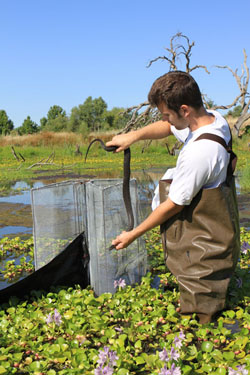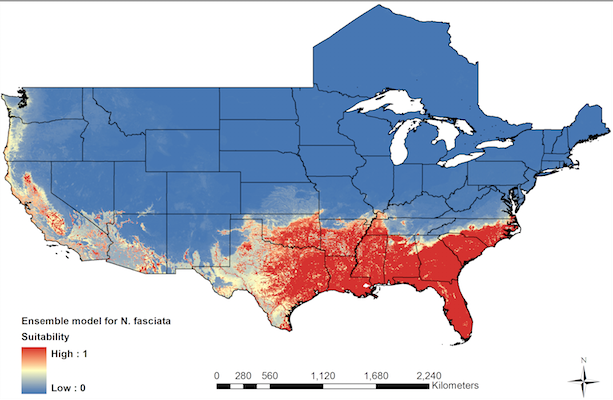Ecology and Invasion Risk of Non-native Watersnakes in California
Supplementary Information
Download North American wetland density GIS layer derived from USGS National Hydrography dataset that was used in Rose and Todd 2014 publication projecting invasion risk of watersnakes in the western US.
Background

Watersnakes of the genus Nerodia are highly aquatic, non-venomous, live-bearing snakes distributed across much of eastern and southern North America. They are related to other live-bearing snakes in the subfamily Natricinae, a group that includes the diverse Garter Snakes of the genus Thamnophis. No species of Watersnake is native to the western US, and historically Watersnakes did not occur west of the Rocky Mountains. Both Garter Snakes and Watersnakes feed on fish and amphibians, although Watersnakes are typically more aquatic. However, given the historical absence of Watersnakes on the west coast, some Garter Snake species have evolved to occupy aquatic niches in the western US similar to those occupied by Watersnakes in the eastern US.
Although their ill temperament and typically foul smell make them unusual pets, Watersnakes are still occasionally captured and sold in the pet trade. Unfortunately, the movement of these species across the US has resulted in their occasional introduction into areas outside of their native range. Due to the similar ecologies and life histories of native Garter Snakes and introduced Watersnakes, these introductions are increasingly a conservation concern for native species and ecosystems in the West. For example, the highly aquatic Giant Garter Snake (Thamnophis gigas) is found in the Central Valley of California and is both federally- and state-protected due to rapid and ongoing population declines over the past few decades. As Giant Garter Snake populations dwindle across the Central Valley, the few remaining robust populations in areas near Sacramento and the Natomas Basin face a looming threat of at least two different Watersnake species that have been introduced into two locations just miles away. Although both the Giant Garter Snake and introduced Watersnakes have similar habitat use and diets, Giant Garter Snakes appear sensitive to habitat alteration whereas Watersnakes seem to thrive in suburban waterways and other altered areas. The risk that introduced Watersnakes will add to declines of native Garter Snake species is just one reason the California Department of Fish and Game outlawed the possession, distribution, sale, export, import, and transport of Watersnakes in 2008.
Objectives
We have several objectives with our work. Our first goal is to determine how widely established Watersnakes currently are in California. Based on previously published reports and other sources, at least 4 different areas in California have established populations of Watersnakes, including:
- Roseville, CA - Nerodia sipedon, Northern Watersnake
- Folsom, CA - Nerodia fasciata, Banded Watersnake
- Long Beach, CA - Nerodia fasciata, Banded Watersnake
- Lafayette, CA - Nerodia rhombifer, Diamond-backed Watersnake (presumed extirpated)
We have begun studies in two of these areas, including Long Beach (with Bob Reed and other USGS biologists) and Roseville. Our goal in thse studies is to examine the demography, ecology, and fecundity of the populations to assess their risk of wider establishment. Any reports of new occurrences in the state should be sent via email to californiawatersnakes@gmail.com. This email address is shared by members of the Nerodia Working Group, a group of collaborators with whom we are trying to address the spread of these non-native snakes in California. There is also a Facebook page "Stop the Spread of Non-Native Water Snakes in California" where you can upload photos or more information.
In addition to studying introduced Watersnake populations presently established in the state, we are using MaxEnt and other modeling tools to predict potential invasive range of Watersnakes in the western US. These models generally use climate data from known occurrences of the snakes in their native ranges and then identify areas with similar climates to predict likely suitable habitat in new areas. Using projection models of both non-native Watersnakes and native Garter Snakes we can identify areas of overlap and predict possible conflict between likely competitive species.

The example map above depicts projected suitable habitat for Nerodia fasciata based on an ensemble model created using occurrences in the species' native range and currently known occurrences in California.
Read more in our recent publication in PLoS ONE on this topic: Rose and Todd 2014.
Additional Links
- Dr. Mike Fuller's California Nerodia site
- Habitattitude website about the harm that can result from released pets
- Don't Turn it Loose! - a brochure from Partners in Amphibian and Reptile Conservation offering guidance about what to do with unwanted pets or unused specimens
- USGS list of nonindigenous reptiles
